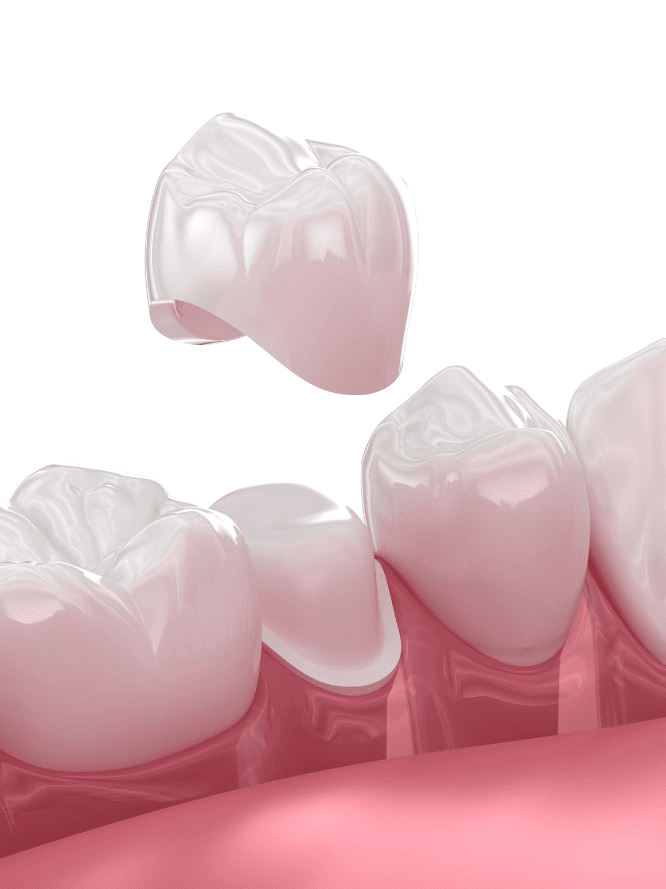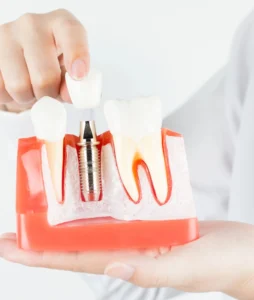Dental crowns are a common solution for restoring damaged or missing teeth. They provide both functional restoration and cosmetic enhancement in the form of either a dental implant crown or a traditional crown.
So, what’s the difference between the two?
Read on to learn more about dental implant crowns versus traditional crowns and which may be better suited for your specific situation.
What Is a Traditional Dental Crown?
A traditional dental crown is a custom-made, tooth-shaped cap placed over a damaged or weakened natural tooth. It restores the tooth’s original shape, size, strength, and appearance, and also acts as a protective cover, encasing the entire visible portion of the tooth above the gum line.
Traditional crowns are commonly needed in various situations where a natural tooth is compromised and a simple filling isn’t sufficient, like:
- Post-Root Canal Treatment
- Extensive Decay
- Fractured or Cracked Teeth
- Large Fillings
- Severely Worn Teeth
- Cosmetic Enhancement
Traditional crowns are crafted from the following materials, each with distinct advantages:
- Porcelain or Ceramic
- Metal (Gold, base-metal alloys)
- Zirconia
- Porcelain-fused-to-metal (PFM)
Your dental clinic in West Hills will help you select the best dental crown material tailored to your specific needs, the location of the tooth, and your aesthetic preferences.
What Is a Dental Implant Crown?
An implant crown is a specific type of dental crown that is attached to a dental implant, not a natural tooth. It is part of a larger system designed for tooth replacement when a tooth is entirely missing. This system provides a complete, independent restoration that replicates the structure of a natural tooth from the root up.
Dental implants, with their attached crowns, are widely considered the gold standard for tooth replacement in West Hills due to their unparalleled stability, exceptional durability, and preservation of jawbone integrity.
Differences Between Traditional and Implant Crowns
The distinction between a traditional crown and an implant crown lies in their support structure and primary purpose:
A traditional crown is supported by an existing, natural tooth to preserve and protect its compromised structure.
An implant crown replaces an entirely missing tooth by integrating with a surgically placed dental implant in the jawbone.
This means a traditional crown requires a healthy natural tooth to bond to, while an implant crown requires sufficient bone density in the jaw to support the implant.
How Are They Placed?
Traditional Crown Placement
1. Initial Exam & Tooth Reshaping
During the first visit, your dentist examines the tooth and prepares it by carefully removing a small amount of enamel from all sides and the top. This creates space for the crown and ensures a proper bite.
Accurate impressions, either with molds or digital scans, are taken and sent to a dental lab to custom-fabricate your permanent crown. A temporary crown is placed to protect the prepared tooth and maintain its position while the permanent one is being made.
2. Final Crown Cementation
On the second visit, the temporary crown is removed. Your dentist meticulously checks the fit, bite, and color of your new permanent dental crown, making any necessary minor adjustments.
The crown is then permanently bonded onto your natural tooth using strong dental cement, restoring full function and natural appearance. This method requires a healthy natural tooth with sufficient remaining structure.
Dental Implant Crown Placement
1. Surgical Placement of Implant Post
The first step is a minor surgical procedure where the titanium dental implant post is placed into the jawbone at the site of the missing tooth. This is often performed by a specialist in general dentistry or an oral surgeon.
2. Healing Period (Osseointegration)
After implant placement, a healing period of 3 to 6 months (or longer) begins. During this time, the biocompatible titanium implant post gradually fuses with the surrounding jawbone through a process called osseointegration, providing a strong, stable, and permanent foundation.
3. Abutment & Crown Placement
Once osseointegration is complete, an abutment is attached to the implant post. After the gum tissue heals around the abutment, final impressions are taken to custom-fabricate your permanent implant crown.
This crown is meticulously designed to match your natural teeth and is then either cemented or screwed onto the abutment, completing the tooth replacement. Sufficient bone density is required, and bone grafting may be necessary for significant bone loss.
Which Option Is Right for You?
Your dentist will help determine the best option based on your specific dental situation, overall health, and long-term goals. That said, here are some basic guidelines:
Choose a traditional crown if:
- The tooth is present but needs reinforcement (e.g., after a root canal, due to decay, fracture, or large filling).
- You prefer a faster, less invasive procedure.
- You are on a tighter upfront budget.
Choose an implant crown if:
- The tooth is completely missing or unsalvageable.
- You want a permanent, highly durable solution that can last a lifetime.
- You are concerned about preventing bone loss in the jaw and maintaining facial structure over time.
- You want to avoid impacting adjacent healthy teeth.
Cost Comparison
A traditional crown typically ranges from $800 to $2,000 per tooth. This varies based on material, complexity, and geographic location. Traditional crowns are often partially covered by standard dental insurance when medically necessary.
An implant crown ranges from $3,000–$6,000 or more per tooth for the entire system (implant, abutment, crown). This higher cost reflects the surgical procedure, advanced materials, and multi-stage treatment. While some dental insurance may cover a portion of the crown or abutment, the surgical implant placement itself is usually not fully covered.
West Hills Smiles offers financing options or payment plans to make treatment more accessible. Despite the higher upfront cost, dental implants are a long-term investment that often proves more cost-effective over time.
Maintenance and Care
Both crown types require diligent oral hygiene and regular dental check-ups for longevity. This includes brushing twice daily, flossing daily, and routine professional cleanings at your dental clinic in West Hills:
- Implant Crowns: The crown itself cannot get cavities. However, effective cleaning around the implant prevents peri-implantitis, an inflammation similar to gum disease that can lead to bone loss around the implant.
- Traditional Crowns: The natural tooth underneath the crown and at its margin is still susceptible to decay. Proper hygiene is vital to prevent bacteria accumulation, which could compromise the crown’s seal or lead to new decay.
For both, if you grind or clench your teeth (bruxism), a custom-fitted night guard is highly recommended to protect your restorations from excessive forces and wear.
Know the Difference & Choose with Confidence
Remember that traditional crowns repair and protect existing natural teeth, while implant crowns comprehensively restore missing teeth.
The best way to determine the right option for your situation is to consult with an experienced dentist who will conduct a thorough assessment, discuss your goals, and explain the implications of each treatment. Choosing the correct solution will significantly improve your chewing function and improve the look of your smile.
Ready to transform your smile? Request an appointment today at West Hills Smiles for all your general dentistry and cosmetic dentistry needs.




